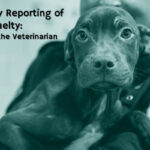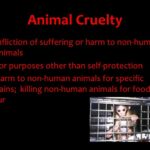In the discourse surrounding the treatment of living beings, the terms “cruelty” and “violence” often surface, occasionally leading to confusion about their distinct natures. Both concepts are intrinsically linked to suffering, yet they embody unique dimensions that merit thorough exploration. This discussion elucidates the convoluted interplay between cruelty and violence, inviting readers to delve deeper into the psychological and sociological underpinnings that govern human and animal interactions.
At its core, “cruelty” is characterized by a willful perpetuation of suffering. This behavior is marked by an absence of empathy or compassion, showcasing an intent to inflict pain or misery upon others, be they human or animal. The manifestations of cruelty are diverse, ranging from overt actions such as physical maltreatment to more insidious forms, such as emotional abuse or neglect. The cruel individual often revels in the power dynamics at play, deriving a perverse pleasure from the distress caused. This enjoyment may stem from a more profound psychological ailment or an ingrained belief in dominance over the weaker.
In contrast, “violence” encompasses a broader spectrum of behavior that results in physical harm or destruction. While it commonly implies physical force, violence can also extend to psychological trauma. The distinguishing factor lies in the means and motives behind such actions. Violence can occur without a malicious intent; for instance, in scenarios of self-defense or aggression born from fear and anxiety. It is a stance often taken out of desperation rather than a desire to dominate or cause suffering for pleasure.
The two concepts converge at points, especially when examining extreme acts. Acts of violence can embody cruelty when they purposefully seek to inflict suffering. For example, a violent incident that occurs with the intent to intimidate or belittle the victim showcases an intersection of cruelty and violence. However, a brawl fueled by anger or self-preservation, where the intention is not explicitly to inflict prolonged suffering, leans more toward mere violence.
Understanding the cognitive and emotional landscapes that give rise to cruelty and violence is crucial for developing better interventions and societal norms. What compels individuals toward cruelty? Psychological theories elucidate a myriad of factors, including upbringing, societal influences, and individual psychopathologies. Often, those who engage in cruel behavior may have themselves been victims of abuse, cycling through an ingrained pattern that perpetuates suffering. Their actions are not merely expressions of unchecked rage; they may also be borne from a profound sense of inadequacy, seeking validation through exerting control over others.
The societal tolerance of violence often plays a pivotal role in fostering brutal behaviors. Cultures that normalize vigorous conflict resolution or celebrate aggressive displays can inadvertently legitimize acts of cruelty. For instance, aggressive sports, violent media portrayals, and punitive systems can desensitize individuals, blurring the lines between acceptable violence and reprehensible cruelty. When violence becomes normalized, it paves the way for cruelty to flourish unchecked, as individuals learn to see suffering as an acceptable byproduct of their actions.
In exploring the fascination mankind has with violence and cruelty, one must confront the morbid curiosity that often shadows these behaviors. The portrayal of cruelty in literature, film, and other mediums often serves not only to entertain but also to challenge social norms. This intrigue may arise from a deep-seated need to comprehend the darker aspects of human nature. The repugnance elicited by cruelty contrasts starkly with an instinctual drive to explore boundaries, whether they are moral, ethical, or psychological. This duality raises significant questions about the human condition, as observing cruelty allows a reflection on societal values and humane principles.
The implications of cruelty and violence extend beyond individual actions; they permeate societal structures and ideologies. Societal violence, which encompasses systemic measures that promote inequality and suffering, can be perceived as a form of collective cruelty. War, famine, and stark socioeconomic disparities illustrate this phenomenon, wherein systems shift toward violence as a means to an end, all while masked by political or ideological justification. Analyzing these broader frameworks reveals how cruelty and violence can operate on macro levels, embedding themselves in the very fabric of societal interactions.
To address these intricate aspects effectively, we must cultivate awareness and compassion across communities. This involves education, systemic reforms, and a commitment to challenging societal norms that condone or glorify brutal behavior. Preventative measures can include fostering emotional intelligence and empathy from an early age, encouraging dialogue around feelings and experiences, and promoting respectful conflict resolution. By unearthing the roots of cruelty and violence, we can unearth methods to constructively address these pervasive issues, moving toward a more compassionate and empathetic society.
In conclusion, while cruelty and violence share a common connection to suffering, they are distinct in their manifestations and motivations. Recognizing the nuances separating the two can empower individuals and communities to confront and dismantle the cycles of harm that plague societies. The path to healing involves not just an acknowledgment of these behaviors but also an active engagement in promoting empathy, understanding, and, ultimately, a rejection of cruelty in all its forms. As we endeavor to dissect the complexities of these issues, we gain not only clarity but also the capacity for transformative change.






